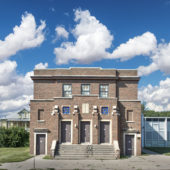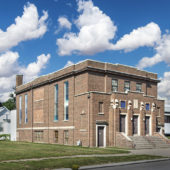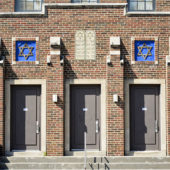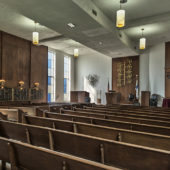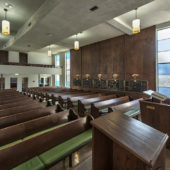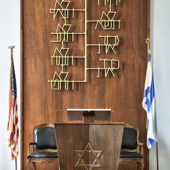One of Iowa’s earliest Jewish congregations.
B’nai Israel Synagogue: an Illustrious History
The first Jewish settler in what was then the Iowa Territory was Alexander Levi, who settled in Iowa in 1833 and became the state’s first naturalized citizen. In 1881, a group of pioneer Jewish settlers in Council Bluffs formed a congregation. This congregation, consisting of 25 charter members, took the name Bikur Cholim and rented a small brick building on Main Street. Unable to afford the services of a rabbi, nonetheless, they worshipped in the traditional form, led by members of their all-male congregation.
In addition to the highly conservative Bikur Cholim congregation, which disbanded shortly after its formation, a reform Hebrew Society was established in 1882. At first the reformists worshipped in whatever building was available, but after a couple of years they created Temple Emanuel in a used building on North Seventh Street. They too disbanded within a couple of years.
In 1903, the orthodox Chevra B’nai Yisroel Congregation was organized, with a membership of 14 men. In 1904, the cornerstone of their first synagogue was laid at 618 Mynster Street. The original structure was a wood frame building, constructed at a cost of $6,000. Julius Katelman, who was in the scrap iron business, and Moritz Marcus, who owned a clothing store, were credited with the success of the project. Since the new synagogue once again lacked the services of a fulltime rabbi, Julius, Moritz, and other men conducted regular services.
Misfortune struck the congregation on the Sabbath night of March 5, 1930, and members of the synagogue stood watching helplessly as a fire reduced the building to ashes. Louis Katelman, upon seeing from his store on Broadway that the synagogue was burning, ran to the building and rushed inside, scooping up the Torah, sacred scrolls, and other religious items.
Although the Great Depression had caused a number of Jewish businesses in Council Bluffs to close, the B’nai Israel congregation scraped together enough funds to build a new structure on the same site, designed by local architect J. Chris Jensen. On January 11, 1932, the rebuilt synagogue, composed of brick this time, was completed. It served a growing congregation throughout the 1930s, ’40s, ’50s and ’60s. Following World War II, the congregation began to shed some of its conservative, orthodox traditions, and women were allowed to sit with men on the main floor of the sanctuary. The congregation also began holding Bat Mitzvah ceremonies for girls, in addition to the traditional Bar Mitzvahs for boys.
The congregation officially changed its name to B’nai Israel in November 1953.The 1960s marked another transition in the size of the congregation; this time a drastic downsizing. After the departure of fulltime Rabbi Emil Klein in 1969, the future once again looked bleak for the congregation. In 1973 the Talmud Torah and Sunday School were closed, and by 1980 plans were being developed to close and auction off the synagogue.
Rose Katelman, whose husband had saved the Torah from the fire almost 50 years earlier, led the effort to save the synagogue. Since most of the old-timers had passed away, she recruited young families from both Council Bluffs and Omaha. One way in which greater interest was raised in the synagogue was a further divergence from the conservative beliefs of the past, to a more contemporary approach to religion. Under the leadership of the liberal Reconstructionist denomination, led first by Rabbi Sheryl Shulewitz, beginning in 1989, the B’nai Israel Synagogue has experienced a rebirth further shepherded by Rabbi Ruth Ehrenstein.
In 2007 B’nai Israel was listed on the National Register of Historic Places by its original name Chevra B’nai Yisroel Synagogue.
Sandra Kurland of Council Bluffs tells the following story:
Back in the 1950s there were parking meters along the street in front of the synagogue. Of course Jewish people could not carry or use money on Shabbat. In order to avoid parking violations the rabbi would call the police department the day before Shabbat and the police would come and place bags over the meters. Eventually the meters were removed.

